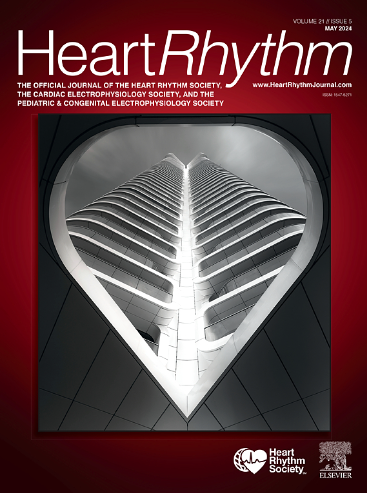周期性起搏点交替导致的空间不和谐交替现象
IF 5.6
2区 医学
Q1 CARDIAC & CARDIOVASCULAR SYSTEMS
引用次数: 0
摘要
本文章由计算机程序翻译,如有差异,请以英文原文为准。
Spatially discordant alternans due to periodic pacing site alternation
Background
Bidirectional ventricular tachycardia (BVT) is a rare type of ventricular tachycardia that is characterized by a beat-to-beat alternation in the QRS axis. Previous studies have shown that it is caused by alternating focal activities from 2 locations.
Objective
This study proposes a novel mechanism for the formation of spatially discordant alternans (SDA) due to the periodic pacing site alternation that occurs in BVT.
Methods
We used mathematical models of cardiac tissue to understand the dynamic and physiologic mechanisms underlying SDA formation.
Results
We found that SDA was formed by periodic pacing site alternation. When tissue was paced from 2 locations alternately, the timing of pacing at distant locations varied, creating a long-short-long-short sequence of pacing periods and thus action potential durations. Importantly, the nodal lines were perpendicular to the wavefront, which is more arrhythmogenic than when nodal lines are parallel to the wavefront. A positive correlation was observed between the separation distance of the 2 sites and the alternans amplitude. SDA patterns can be predicted from the tissue geometry and pacing site locations.
Conclusion
Periodic pacing site alternation, which occurs in BVT, leads to arrhythmogenic SDA. The nodal lines associated with this phenomenon can be predicted on the basis of tissue geometry and focal locations.
求助全文
通过发布文献求助,成功后即可免费获取论文全文。
去求助
来源期刊

Heart rhythm
医学-心血管系统
CiteScore
10.50
自引率
5.50%
发文量
1465
审稿时长
24 days
期刊介绍:
HeartRhythm, the official Journal of the Heart Rhythm Society and the Cardiac Electrophysiology Society, is a unique journal for fundamental discovery and clinical applicability.
HeartRhythm integrates the entire cardiac electrophysiology (EP) community from basic and clinical academic researchers, private practitioners, engineers, allied professionals, industry, and trainees, all of whom are vital and interdependent members of our EP community.
The Heart Rhythm Society is the international leader in science, education, and advocacy for cardiac arrhythmia professionals and patients, and the primary information resource on heart rhythm disorders. Its mission is to improve the care of patients by promoting research, education, and optimal health care policies and standards.
 求助内容:
求助内容: 应助结果提醒方式:
应助结果提醒方式:


